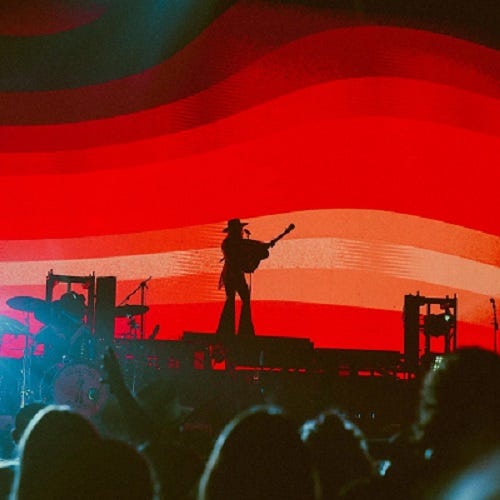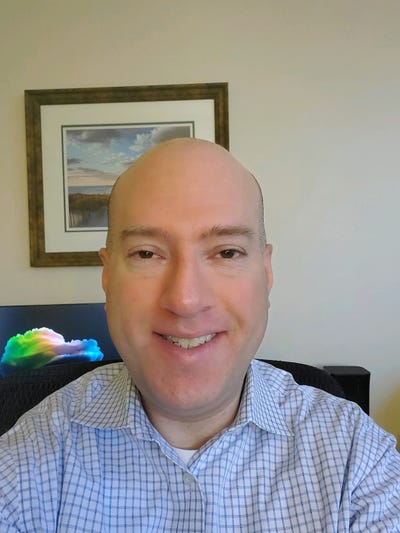High-Tech Projection Design: From Music Festivals to the Broadway StageHigh-Tech Projection Design: From Music Festivals to the Broadway Stage
A creative talent behind major theater productions and live acts, Olivia Sebesky shares with information how graphic design programs and media servers bring complex visual displays to life.

In 2023, the entertainment industry saw some of the most eye-popping displays ever, from the immersive round screens at U2’s The Sphere shows in Las Vegas to the widely popular tours of Taylor Swift and Beyoncé. Meanwhile, over her career projection designer Olivia Sebesky has designed a wide range of shows, from an Aerosmith tour and Carrie Underwood Stagecoach performance to most recently the visual designs of Broadway’s "Melissa Etheridge: My Window." In fact, Sebesky has been nominated for Media Content Creator of the Year at tonight’s Parnelli Awards for the live event industry for video content on country star Lainey Wilson’s tour. She’s up against the content creators for Beyoncé, Erykah Badu, P!nk, SZA, and U2 at the Sphere.
Sebesky started as a painter and then developed into a projection and video designer, which allowed her to experiment with gestures on a large scale. Her career progressed from the paint easel to an electronic production board at high-profile entertainment events. She’s seen productions move from 1080p to 8K video presentations.
“I am just behind a screen and all this gear all day long, and it doesn't change how much it’s driven by art,” Sebesky tells information. “It’s just a totally different way of working.”
How Sebesky Creates Her Designs
Although Sebesky has colleagues that built Windows towers for design, Sebesky’s preference is to use Apple’s Mac Studio for her work. She has two new Mac Studio machines and prefers its portability and its speed for render times. For design, Sebesky uses Unreal Engine to create real-time 3-D content and relies on After Effects for 2-D animation. Sebesky would like to see Unreal offer animation as well.
“The biggest challenge for somebody like me is dealing with the relationship between software and hardware,” Sebesky explains. “If your machine is souped up, it will only be as good as the software catching up to the hardware and vice versa. So when you have both of those things working together, that's the magic of how to make everything optimized.”
Sebesky renders production design files on the computer as media files and transfers them to a venue’s Disguise media server through a video input card.
The signal flows from the media server to the LED screens onstage. But the type of LED screens varies depending on the project. On a tour, technicians are assigned to every single element, such as LED, Sebesky says.
“The way that works is a whole ‘art’ in itself,” she says. “There's a Disguise programmer who's an expert in the program. I work tangentially with that person, and I give them the media files. Then it becomes a collaboration on-site where we put the files up on the screen. At scale, we are changing things around, we’re slowing things down, speeding them up, [adjusting] color and balance, all these things happen once it goes into the room.”
Design Varies From Music Festivals to Broadway
Sebesky says her most technically complex work was the MDLBEAST Soundstorm 2021 festival in Riyadh, Saudi Arabia. The lineup for the December 2021 Soundstorm show included The Chainsmokers, David Guetta, and Jason Derulo. The show consisted of five stages with “massive LED parks,” she says. Sebesky designed the projection for one of the five stages.
While designing Lainey Wilson’s tour, Sebesky recalls a moment that was impactful for her.
“The structure of the set is that it's a big LED screen. Then there's a scenic, thrust structure, and a ladder that goes right up to the screen, so when [Wilson] stands right in front of the screen, we don't light her,” Sebesky says. “She's just backlit from the LED screen. She's in full silhouette.”
Sebesky says Wilson goes for a funk-inspired design. The country star appeared in silhouette with an undulating graphic and large shapes behind her.

Lainey Wilson on stage by Olivia Sebesky
“To not light an artist is a pretty big gesture, so it was really cool that we were able to do that,” Wilson says. “Usually, the goal is to keep the [main act] lit the entire show, and doing the opposite is just as impactful if done really well.”
Sebesky described how the tech behind shows varies depending on if it’s a musical act moving from city to city compared with a production that stays in the same theater for an extended period of time, such as Etheridge’s Broadway show. Sebesky and her team can consider where to hang projectors without worrying about multiple venues, she says.
“We designed the system around where we can hang the projector in the space, and we never have to think about a different space for it,” Sebesky says. “That's the biggest difference when you're trying to create the technology package for any given show. You have one space that you stay in for months compared with tearing it down and going to the next city the next day.”
Experimenting With AI
Sebesky has been experimenting with artificial intelligence to see how it can improve her workflow. She’s performed preliminary experimentation with image-generation software to help with storyboarding as she prepares to pitch concepts to clients.
“Imagery search can take hours and hours,” Sebesky says. “So, if you can just say I need an image of musical notes floating above the ocean, it spits it out for you. It won't look the way it needs to look eventually down the road, but I think that's helpful.”
What to Read Next:
How High-Tech Projection Design Powers Immersive Entertainment Experiences
About the Author
You May Also Like






